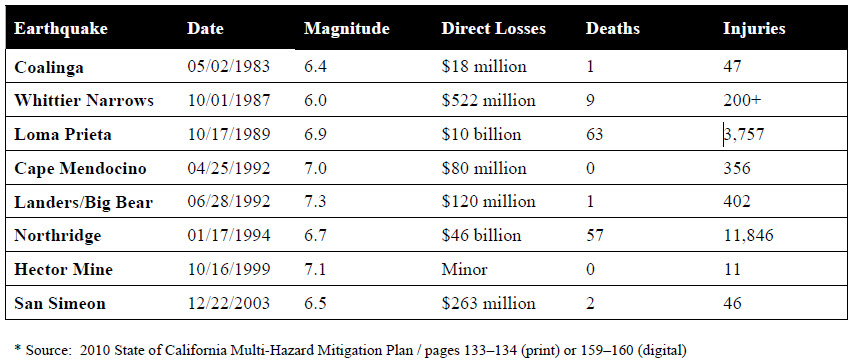For CEA media contact information, visit the Press Releases page.
CEA to offer more earthquake-insurance choices for Californians seeking to protect their homes and personal finances
SACRAMENTO, Calif. – Starting July 1, 2012, the California Earthquake Authority (CEA) will offer its new Homeowners Choice product line. The new product will give residents greater control over their earthquake insurance premium and the ability to select (or decline) coverage of their personal property––for homeowners, the personal property coverage will be more accessible through a new deductible structure.
"CEA's new Homeowners Choice coverage options can help our policyholders take more control of their earthquake-insurance premiums," said CEA CEO Glenn Pomeroy. "With just 10 percent of Californians currently buying earthquake-insurance coverage, this new product is an important step toward helping more people protect their homes and personal finances from the devastating disruption of a major earthquake."
CEA's new Homeowners Choice policy complements CEA's continued availability of its standard Homeowners policy, which bundles in a single policy coverage for the dwelling, personal property, and additional living expenses. By offering both policies, CEA can help homeowners choose and even customize the right policy to meet their earthquake-insurance and household-budget needs.
California has 70 percent of America's earthquake risk, yet most residents don't buy earthquake insurance. Without earthquake insurance to help recover from catastrophic damage, residents may be responsible for all costs to repair or rebuild their homes and to replace their personal property, as well as to live and eat elsewhere while their homes are being repaired or rebuilt.
Government disaster-assistance programs, if available, adhere to strict eligibility criteria – and might not always be available. If disaster grants are available, and if residents qualify, they may not receive funds sufficient to repair or rebuild their homes and to replace their personal property. And if government loans are available, they may be limited, and residents must repay them.
"Earthquake insurance from the CEA gives Californians the strength to rebuild," Pomeroy said. "It can help people get their lives back to normal after the ground stops shaking."
Homeowners can contact their insurance agent or company for an accurate quote or use the CEA's Premium Calculator at www.EarthquakeAuthority.com to get an estimate.
About the CEA With nearly $10 billion in claim-paying power, combined with the service expertise provided by its 19 participating insurance companies, the CEA could cover all of its claims if the 1906 San Francisco, 1989 Loma Prieta, or 1994 Northridge earthquake reoccurred today.
Visit www.EarthquakeAuthority.com for more information about the California Earthquake Authority.
Damaging earthquakes in California over the past 30 years
What scientists are saying about earthquakes in California
- There is more than a 99 percent probability that in the next 30 years Californians will experience one or more Magnitude 6.7 or greater earthquakes, which can potentially cause extensive damage and loss of life.**
- Earthquakes large enough to cause moderate damage to structures – those of Magnitude 5.5 or larger – occur in California three to four times a year.
- Strong earthquakes of Magnitude 6 to 6.9 strike in California an average of every two to three years.
- Major earthquakes of Magnitude 7 to 7.9 occur in California once every 10 years.
- Two recent major earthquakes, the 1992 Landers earthquake (Magnitude 7.3) and the 1999 Hector Mine earthquake (Magnitude 7.1), caused extensive surface fault rupture but relatively little damage because they occurred in lightly populated areas of the Mojave Desert. In contrast, earthquakes of smaller magnitude but in densely populated areas, such as the 1989 Loma Prieta earthquake (Magnitude 6.9), have caused extensive damage over large areas.
- A major earthquake near one of California's urban centers could cause unprecedented losses.
**Source: Uniform California Earthquake Rupture Forecast, Version 2, or "UCERF" 2007

